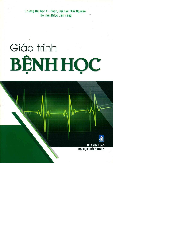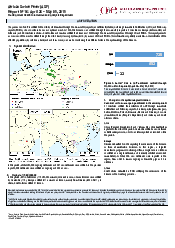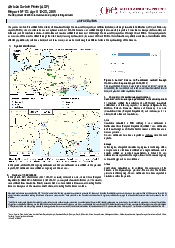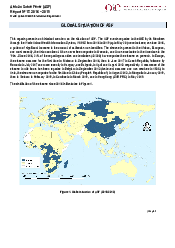
Preview text:
African Swine Fever (ASF) Report N° 1 :
3 March 15 – March 28, 20 9 1
World Animal Health Information and Analysis Department ASF SITUATION
The presence of ASF is notified to the OIE by its Members through the Six-monthly reports (as sufficiently stable) or through Immediate Notifications (IN’s) and Follow-up
reports (FUR’s), when considere
d as an exceptional event. In 2018, this disease was notified through the six-monthly reports in 3 countries in Europe (Estonia, Italy and
Lithuania) and 21 countries in Africa1. South Africa and Zambia notified the disease in 2018 through the Six-monthly reports and through IN and FUR’s. This report presents
an overview of the events notified through the OIE’s Early Warning System (EWS) by means of IN and FUR’s. This information is publicly available2. A classification of the
affected population (by wild boar, backyard an farm swine d
) was made considering their different roles in the epidemiology of the disease. 1. Spatial distribution 2. Impact of the disease
In this period, 97% of all losses (2,877 o f2,96 3 animals) occurred
in Asia, where Vietnam notified the majority of all losses (2,87 6 of
2,963). In contrast, China (People's Republic of) notified only 91
losses from a single outbreak; this portraits a decrease in the impact
of the disease in this country considering the 3,322 animals notified
as losses in the previous period. In Europe only 86 losses were
notified from Moldova, Romania and Russia. In Africa, no new losses were reported.
Figure 2. Losses* due to ASF outbreaks notified through
WAHIS within the period (March 15 - 2 , 2019) 8
The impact of this disease is measured in terms of losses*, which are
calculated by the sum of dead and cul ed animals from the infected farm or
backyard premises of the reported outbreak. 3.
Changes in the epidemiological situation
Countries with new or ongoing outbreaks in the current period:
13 countries notified ASF through immediate notifications and
follow-up reports, 9 in Europe (Belgium, Bulgaria, Hungary, Latvia,
Moldova, Poland, Romania, Russia and Ukraine) and 3 in Asia
(China (People’s Republic of); Mongolia and Vietnam). In Africa,
Zimbabwe’s event is still ongoing. No outbreaks were notified in farmed swine. Asia
The spread of the disease continues in Vietnam, a total of 2 3
administrative divisions have been affected. China (People's
Republic of) submitted an IN reporting the recurrence of the disease
in Chongking. Moreover, Mongolia has not submitted updates to their ongoing situation, 3
outbreaks are still ongoing (see Figure 1). Europe
In this region, a targeted surveillance program is continuing. Often,
a single case in wild boar is notified as a single outbreak. Russia
reported the recurrence of the disease in domestic pigs (last
outbreak resolved in October 2018). Moldova notified the
In this period, a total of 1,351 ongoing outbreaks and 265 new outbreaks were notified. In the previous recurrence of ASF in backyard swine.
report 1,320 outbreaks were notified as ongoing and 28 as new. 9 Africa
Zimbabwe notified that no new outbreaks occurred. Quarantine and
surveillance activities are still on-going in the country.
Member Countries are reminded that the OIE Terrestrial Animal Health Code provides comprehensive guidance to Veterinary Authorities for establishing a country, zone and compartment free of African swine fever (ASF)
as wel as recommendations relating to the trade of pork and pork products. These products, when handled in accordance with hygienic practices complying with international standards, should not present a risk of infection.
The OIE also encourages Member Countries to implement enhanced national sanitary measures on waste disposal from aircrafts/vessels/passengers and enhanced on-farm biosecurity measures – including the protection
of pigs from untreated swil feeding and the effective separation between domestic pigs and wild boar – and stresses the importance of OIE international standards for risk management of transboundary animal diseases
(TADs) to reduce the risk of exporting disease to trading partners. For an overview on the historical distribution of the disease since 2016, please refer to the ASF report N° 1 (available in the official website of the OIE.
1 Benin, Burkina Faso, Cabo Verde, Central African Republic, Congo (Democratic Rep. Of), Congo (Rep. Of), G m
a bia, Ghana, Guinea-Bissau, Madagascar, Malawi, Mozambique, N
amibia, Nigeria, Senegal, Sierra Leone, South Africa,
Tanzania, Togo, Uganda and Zambia. 2 WAHIS interface



